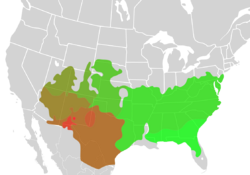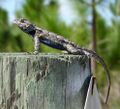Biology:Eastern fence lizard
| Eastern fence lizard | |
|---|---|

| |
| Eastern fence lizard (Sceloporus undulatus), Amelia Court House, VA | |
| Scientific classification | |
| Domain: | Eukaryota |
| Kingdom: | Animalia |
| Phylum: | Chordata |
| Class: | Reptilia |
| Order: | Squamata |
| Suborder: | Iguania |
| Family: | Phrynosomatidae |
| Genus: | Sceloporus |
| Species: | S. undulatus
|
| Binomial name | |
| Sceloporus undulatus (Bosc & Daudin, 1801)[2]
| |

| |
| The ranges of different S. undulatus subspecies are indicated by color. (note: map is missing distribution in New York State) | |
| Synonyms | |
| |
The eastern fence lizard (Sceloporus undulatus) is a medium-sized species of lizard in the family Phrynosomatidae.[3] The species is found along forest edges, rock piles, and rotting logs or stumps in the eastern United States . It is sometimes referred to as the prairie lizard, fence swift, gray lizard, northern fence lizard, plateau lizard or pine lizard.[4] It is also referred to colloquially as the horn-billed lizard.
Taxonomy
The generic name, Sceloporus, is derived from the Greek skelos/σκελος, meaning "leg", and the Latin porus, meaning "hole", referring to the enlarged femoral pores found in this genus of lizards. The specific name, undulatus, is Latin for "wave", referring to the transverse dark crossbars on the backs of these lizards.[5]
Until 2002, 10 subspecies of S. undulatus were recognized,[6] but re-evaluation showed paraphyly between the subspecies. These were reclassified as four distinct evolutionary species (the three new species being S. consobrinus, S. tristichus, and S. cowlesi). The narrowed redefinition of S. undulatus has been suggested to still contain two subspecies divided by the Appalachian Mountains. None currently hold formal recognition.[7]
The following cladogram is based on Leaché and Reeder, 2002:[7]
| |||||||||||||||||||||||||||||||||||||||||||
Description
The eastern fence lizard can grow from 4.0 to 7.5 inches (10 to 19 cm) in total length (including tail).[8] It is typically colored in shades of gray or brown, and has keeled scales, with a dark line running along the rear of the thigh. A female is usually gray and has a series of dark, wavy lines across her back. The belly is white with black flecks, with some pale blue on the throat and belly. The male is usually brown, and during the summer, has a more greenish-blue and black coloration on the sides of the belly and throat than the female. The young look like the females, but are darker and duller.
The lizards mostly inhabit sparsely wooded areas with ample sunlight, such as pine barrens with sandy or loose soil. They can be found basking atop of both natural and artificial structures including coarse woody debris, tree stumps, rock piles, sandy hills, dead logs, and fence posts. They are most active in the early morning sun when the ground has not been fully warmed up yet. They seek refuge inside structures during the day when it gets too hot and at night.
Distribution
The eastern fence lizard is found in Florida, Alabama, Louisiana, Arkansas, Colorado, Georgia, North Carolina, South Carolina, West Virginia, Virginia, Indiana , Kentucky, Southern Illinois, Southern Indiana, Tennessee , Ohio, Pennsylvania, Maryland, Missouri, Mississippi, Delaware, northern Florida, southern Wyoming, northeastern Pennsylvania, southern New Jersey, and southeastern New York.[7]
There are some introduced populations of eastern fence lizards, the most well known in Staten Island. In 1942, Carl Kauffeld released 29 of the lizards near Rossville where they still persist today in post oak-blackjack oak barrens.[9][10] This introduction was done so Kauffeld could have an easy source of food for the lizard-eating snakes at the Staten Island Zoo, as he would otherwise have to drive to the Pine Barrens to collect the lizards for the snakes.[11][12] There have also been sightings of the fence lizards in northern Pennsylvania and southern New York, suggesting that their range may be expanding north.[13]
Reproduction
Male eastern fence lizards will establish a territory in the early spring, doing push-ups to flash their blue scales and deter other males. Female fence lizards will enter this territory, upon which they are courted by the male. The female then finds a suitable location to lay her eggs, usually in a rotting log or similarly damp area, and deposits them without any further parental care.[14] Young females will only produce one clutch of three to sixteen eggs, while a large female can produce up to four.[15] The eggs take approximately ten weeks to hatch and emerge near the end of summer. The young lizards grow quickly and are able to reproduce the next year.
Response to fire ant predation
Within the past 70 years, according to a study published in 2009, eastern fence lizards in parts of their range have adapted to have longer legs and new behaviors to escape the red imported fire ant, which can kill the lizard in under a minute.[16] Red imported fire ants threaten eastern fence lizards because they occupy their microhabitats causing mortality or relocation. Moreover, according to a study published in 2016, artificial eastern fence lizard nests were shown to be vulnerable to predation by red imported fire ants, resulting in nonviability of the eggs.[17]
Gallery
References
- ↑ Hammerson GA, Lavin P, Vazquez Díaz J, Quintero Díaz G, Gadsden H (2007). "Sceloporus undulatus ". IUCN Red List of Threatened Species 2007: e.T64156A12749881. doi:10.2305/IUCN.UK.2007.RLTS.T64156A12749881.en. https://www.iucnredlist.org/species/64156/12749881. Database entry includes justification for why this species is of least concern.
- ↑ Bosc [LAG], Daudin [FM] (1801). In: Sonnini CS, Latreille PA (1801). Histoire Naturelle des Reptiles, avec figures dessinées d'après nature. Tome II [Volume 2]. Première partie. Quadrupèdes et bipèdes ovipares. Paris: Deterville. (Crapelet, printer). 332 pp. (Stellio undulatus, new species, pp. 40-42). (in French).
- ↑ Powell et al. (2016).
- ↑ Lizards. Conservation Commission of Missouri (2014).
- ↑ Liddell HG, Scott R (1980). Greek-English Lexicon, Abridged Edition. Oxford, United Kingdom: Oxford University Press. 804 pp. ISBN:0-19-910207-4.
- ↑ S. u. consobrinus, S. u. cowlesi, S. u. elongatus, S. u. erythrocheilus, S. u. garmani, S. u. hyacinthinus, S. u. speari, S. u. tedbrowni, S. u. tristichus, and S. u. undulatus.
- ↑ 7.0 7.1 7.2 Leaché AD, Reeder TW (2002). "Molecular systematics of the eastern fence lizard (Sceloporus undulatus): A comparison of parsimony, likelihood, and Bayesian approaches". Systematic Biology 51 (1): 44–68. doi:10.1080/106351502753475871. PMID 11943092.
- ↑ Conant, Roger; Collins, Joseph T. (1991). A Field Guide to Reptiles and Amphibians Eastern/Central North America. Boston, Massachusetts: Houghton Mifflin Company. 608 pp.. ISBN 0-395-58389-6. https://archive.org/details/fieldguidetorept00cona..
- ↑ "Online Conservation Guide for Sceloporus undulatus". April 4, 2006. https://guides.nynhp.org/fence-lizard/.
- ↑ "Species Assessment for Eastern fence lizard". September 6, 2013. https://www.dec.ny.gov/docs/wildlife_pdf/sgcnefencelizard.pdf.
- ↑ Finger, Corey (May 30, 2011). "Lizards of New York City". https://www.10000birds.com/lizards-of-new-york-city.htm.
- ↑ Wollney, Clay (August 19, 2014). "Have you seen lizards on Staten Island?". Staten Island Advance. https://www.silive.com/news/2014/08/have_you_seen_lizards_on_state.html.
- ↑ Carlo, Michael (May 4, 2016). "A brief introduction to the Eastern fence lizard". https://experiment.com/u/5mQAbQ.
- ↑ "Eastern Fence Lizard". https://www.nwf.org/Educational-Resources/Wildlife-Guide/Reptiles/Eastern-Fence-Lizard.
- ↑ "Eastern Fence Lizard (Sceloporus undulatus)". https://srelherp.uga.edu/lizards/sceund.htm.
- ↑ "Lizards' Dance Avoids Deadly Ants". LiveScience. 26 January 2009.
- ↑ Thawley, Christopher J.; Langkilde, Tracy (June 2016). "Invasive fire ant (Solenopsis invicta) predation of eastern fence lizard (Sceloporus undulatus) eggs". Journal of Herpetology 50 (2): 284–288. doi:10.1670/15-017.
| Wikimedia Commons has media related to Sceloporus undulatus. |
External links
- Species Sceloporus undulatus at The Reptile Database
- Pictures and resource information on the eastern fence lizards
- Care sheet for pet owners of the eastern fence lizard
Further reading
- Behler, John L.; King, F. Wayne (1979). The Audubon Society Field Guide to North American Reptiles and Amphibians. New York: Alfred A. Knopf. 743 pp., 657 color plates. ISBN:0-394-50824-6. (Sceloporus undulatus, pp. 529–530 + Plate 375).
- Powell R, Conant R, Collins JT (2016). Peterson Field Guide to Reptiles and Amphibians of Eastern and Central North America, Fourth Edition. Boston and New York: Houghton Mifflin Harcourt. xiv + 494 pp., 47 Plates, 207 Figures. ISBN:978-0-544-12997-9. (Sceloporus undulatus, p. 298 + Plate 27 + Map on p. 294).
- Smith, Hobart M.; Brodie, Edmund D., Jr. (1982). Reptiles of North America: A Guide to Field Identification. New York: Golden Press. 240 pp. ISBN:0-307-13666-3 (paperback), ISBN:0-307-47009-1 (hardcover). (Sceloporus undulatus, pp. 122–123).
- Zim HS, Smith HM (1956). Reptiles and Amphibians: A Guide to Familiar American Species: A Golden Nature Guide. New York: Simon and Schuster. 160 pp. (Sceloporus undulatus, pp. 57, 155).
Wikidata ☰ Q2288496 entry







